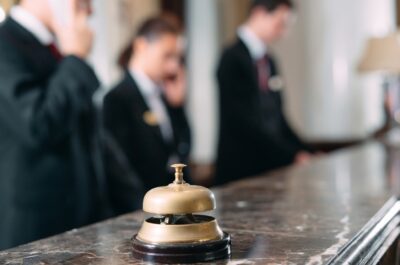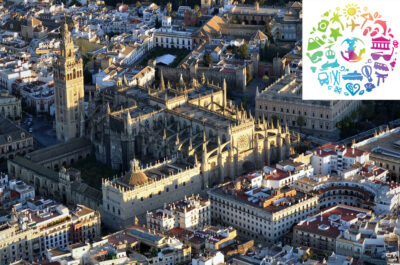The restored and reinvented Hotel Alfonso XIII, remains a Sevillian icon with a smooth combination of its old and galmourous new features.
LONDON – Affirming its pre-eminence among the great hotels of Europe, cherished Sevillian icon Hotel Alfonso XIII has been restored and reinvented by The Gallery, the studio within HBA’s London team that is dedicated to the interior design of highly specialised bespoke projects. The designers have woven together a full-bloodied narrative, drawing on the vivid history and culture of Andalucia, of which Seville is the capital, as well as the inheritance and soul of the grand dame herself.
Conceived by King Alfonso XIII, the hotel originally opened in 1929 during the Art Deco era and became one of the essential stopovers for travellers during the “Golden Age of Travel”. Here lay the heart of Andalucia with its 500 years of Moorish occupation, the cradle of bull fighting and the flamenco dance and home to Don Juan, the legendary lover – a heady mix that prizes tough masculinity and dark, mysterious female charms. The Gallery has crafted a seductive story from these themes and, by carefully conserving and enhancing the old and combining this with beautiful new features, has taken the Luxury Collection hotel forward into the next era of glamour.
First impressions count, and the Hotel Alfonso XIII lives up to every expectation. The open double-height reception space is adorned with gleaming and intricately patterned marble floors; dramatic marble stairs; bas-relief decorated crown mouldings; a rich coffered ceiling from which hangs gorgeous period chandeliers; and lavish frescos above soaring arched passageways – all of which combine to create a rare degree of opulence. These original surfaces were to remain untouched; even adding an electrical socket to accommodate a new lighting arrangement was impermissible. In this case, The Gallery took exact measures of the location of each socket in the lobby to understand the constraints and options for relocating furniture.
The reception desk has now been dressed in crimson leather panels embossed with the hotel’s logo. Large, original azulejos – the ornate ceramic tiles native to Seville – are hand-painted with a vivid azure and mustard palette which inspired the lobby’s new and reupholstered furnishings. Enticing views of an al fresco dining courtyard are encircled by exquisite mosaic-clad colonnades. The design team made the most of the radiant sunlight which floods into the arcades, re-planning the space so that one half is the lobby lounge and the other hosts the all-day dining area – now relocated from a back room into the luminous gallery. Flexible furnishing layouts enable a variety of social events, while natural and tobacco-coloured rattan textures and button-tufted chairs, mixed with existing antiques, invite guests to relax in a setting resplendent with old-world panache.
There is a wide choice of wining and dining spaces, each offering a distinct experience. A re-imagined version of the original but long-lost American Bar evokes a sophisticated Art Deco feel, with lacquered walls draped in a silky robin’s egg blue fabric, accented with a lustrous golden fringe; grand mirrors with polished blue lacquer frames; and a bar finished in polished brass and Macassar Ebony timber. Bodega Alfonso, by contrast, clearly belongs to old Seville with its Moorish forms; a traditional and rich colour palette; weathered oak planks fixed with iron rivets that form the bar; and a majestic painting of King Alfonso XIII staring down over proceedings.
Alternatively, guests may chill-out poolside or experience the casual Moorish style of the new Taifas restaurant and bar. Because this existing free-standing building was not connected to the main hotel, The Gallery was given free creative rein for the transformation of this former utility space into a stylish venue. Rich timber wine cabinets fitted with antique brass screens cabinets sit behind the Carrara marble topped bar, and the ceiling is embellished with an ornately patterned plaster lattice ceiling. A backlit carved Moorish screen defines the separate dining area, where low seating accented with embroidered cushions creates a lively transition between indoor and outdoor dining spaces. Hand-painted encaustic tiles and colourful staggered pendant lights crafted by local ironmongers brings vibrancy to the clean white space.
In response to a Sevillian law requiring music in public venues to stop at midnight, the below ground levels of the hotel were stripped out to transform previous back-of-house areas into meeting rooms that allow parties to continue into the early hours. Luxury touches such as linen covered walls, rustic oak plank floors and vibrant crimson leather accents inset into the millwork maintain the sense of refinement seen in the hotel’s other ballroom and meeting spaces. The existing ground-level fitness centre was also expanded through the addition of glazing that opens-up the space onto the hotel’s leafy landscape. A yoga garden was introduced, as well as a sauna adorned with local “zellige” tiles in a Moorish pattern.
The hotel features a collection of guestrooms, designed in three styles, which between them harness the major influences on the make-up of Seville: Moorish, Andalucian and Castilian. The Moorish rooms are a treasure trove of intricately detailed restored mouldings, dramatically fashioned furnishings and voluptuously shaped features. Flamenco dancing inspires the Andalucian bedrooms; the sculptural “swish” shapes carved into their cornices conjures up the flick of a flamenco skirt that reveals a flash of colour and ruffles. This has been interpreted into a feminine décor which balances finely patterned textiles with flamboyantly studded leather headboards. While the Andalucian rooms celebrate beautiful women, the Castilian rooms capture the power of young men – the captivating masculinity of the matador as he powerfully brandishes his exquisitely embroidered cape in the bullfighting arena. A deep ochre palette is enlivened by flaunts of vibrant colours and enriched by dark timber furnishings such as the elaborately carved headboards. In the artwork, a singular flourish boldly painted on a canvas conveys a potent sense of drama.
The Royal Suite has been imagined by The Gallery to be the luxury residence where King Alfonso XIII would have stayed, and is endowed with portraits and artefacts from his frequent travels, curated from the hotel’s private collection. Priceless antiques are combined with sumptuous new furnishings, such as television cabinets sheathed in hand-gilded leather and, in the master bedroom, the draped four-poster bed is enveloped in fluid, hand-embroidered fabrics.
Overlooking the fabulous gardens of the neighbouring palace is the Reales Alcázares Suite. The designers envisioned this space as the private boudoir of María de Padilla, the secret mistress of the legendary King Pedro the Cruel. In the living room, charcoal walls cast a tone of clandestine and moody seduction which is brightened by flirtatious Chinoiserie patterns that play upon the joyful aspect of the greenery outside. The master bedroom is heavily draped with plush deep-toned velvets combined with wrought iron furniture, while the second bedroom is dramatically dressed in scarlet red.
Inge Moore, Principal of The Gallery and HBA London, summarises the design team’s experience: “With the restoration of the legendary Hotel Alfonso XIII, we were given both an exceptional challenge and opportunity to enhance the soul of this beloved treasure, a must-see architectural landmark in its own right. Our research into the stories of Seville’s layered heritage and reimagining of the hotel invites guests to join in the discovery of the passionate Andalucian culture through a design abundant with the best of today’s comforts.”
Tatiana is the news coordinator for TravelDailyNews Media Network (traveldailynews.gr, traveldailynews.com and traveldailynews.asia). Her role includes monitoring the hundreds of news sources of TravelDailyNews Media Network and skimming the most important according to our strategy.
She holds a Bachelor's degree in Communication & Mass Media from Panteion University of Political & Social Studies of Athens and she has been editor and editor-in-chief in various economic magazines and newspapers.


































































































































































































































